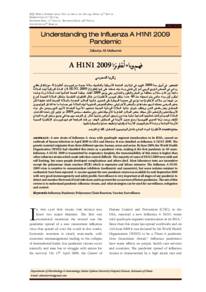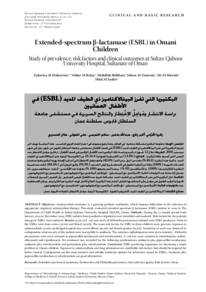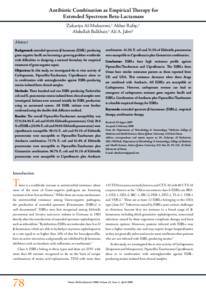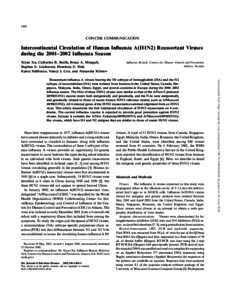Document
Understanding the influenza A H1N1 2009 pandemic.
Other titles
فهم وباء أنفلونزا A H1N1 2009
Publisher
College of Medicine, Sultan Qaboos University.
Gregorian
2010-08
Language
English
Subject
English abstract
A new strain of Influenza A virus, with quadruple segment translocation in its RNA, caused an outbreak of human infection in April 2009 in USA and Mexico. It was classified as Influenza A H1N1 2009. The genetic material originates from three different species: human, avian and swine. By June 2009, the World Health Organization (WHO) had classified this strain as a pandemic virus, making it the first pandemic in 40 years. Influenza A H1N1 2009 is transmitted by respiratory droplets; the transmissibility of this strain is higher than other influenza strains which made infection control difficult. The majority of cases of H1N1 2009 were mild and self limiting, but some people developed complications and others died. Most laboratory tests are insensitive except the polymerase chain reaction (PCR) which is expensive and labour intensive. The Influenza A H1N1 2009 virus is sensitive to neuraminidase inhibitors (oseltamivir and zanamivir), but some isolates resistant to oseltamivir have been reported. A vaccine against the new pandemic strain was available by mid-September 2009 with very good immunogenicity and safety profile. Surveillance is very important at all stages of any pandemic to detect and monitor the trend of viral infections and to prevent the occurrence of future pandemics. The aim of this review is to understand pandemic influenza viruses, and what strategies can be used for surveillance, mitigation and control.
Member of
Resource URL
Citation
Al-Muharrmi, Zakariya (2010). Understanding the Influenza A H1N1 2009 Pandemic. Sultan Qaboos University Medical Journal, 10 (2), 187–195.
Arabic abstract
في أبريل، سنة 2009 ظهرت في الولايات المتحدة الأمريكية والمكسيك سلالة جديدة من فيروسات أنفلونزا A مع إنتقال حلقي رباعي في الحمض النووي الريبي أدت إلى تفشي وباء، وقد صنفت على إنها إنفلونزا ( 2009 (AH1N1 المادة الوراثية لهذه السلالة ناتجة عن ثلاث سلالات مختلفة من البشر والطيور والخنازير. وفي يونيو 2009 أعلنت منظمة الصحة العالمية هذه السلالة وباء جائحا ليكون أول وباء عالمي يتم تسجيله منذ 40 عاما. ينتقل فيروس الأنفلونزا من خلال القطيرات التنفسية، وتنتقل السلالة الجديدة أسرع من غيرها من سلالات الإنفلونزا مما يؤدي إلى صعوبة السيطرة على العدوى غالبية الحالات المصابة بالسلالة الجديدة كانت خفيفة لكن بعض المرضى حصلت لديهم مضاعفات والبعض الآخر .توفي معظم الفحوص المخبرية لهذه السلالة غير حساسة ما عدا تفاعل البوليميريز المتسلسل وهو باهض الثمن ويتطلب خبرات عالية السلالة الوبائية الجديدة تستجيب للأدوية المضادة لأنزيم النيور مينديز مثل دواء الأوسيلتا مفير والزنمفير، لكن سجلت بعض الحالات المقاومة للأوسيلتامفير. وفي منتصف سبتمبر 2009 تم توفير أول شحنه للقاحات السلالة الجديدة وكانت فعاليتها المناعية عالية جدا دون تسجيل أعراض جانبية تذكر. إن الترصد مهم جدا في جميع مراحل الوباء الجائح لكشف ورصد نزعة العدوى الفيروسية ومنع حدوث الأوبئة في المستقبل الهدف من هذه المراجعة هو فهم فيروسات الإنفلونزا المسببة للأوبئة الجائحة ودراسة الاستراتيجيات اللازمة لمراقبتها وتخفيف حدتها والسيطرة عليها.
Category
Journal articles




